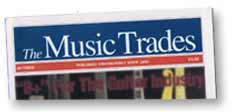




| IBM shocked the business world a couple of years ago by announcing that it was scrapping its "suit law" in favor of a more casual dress code. As part of a massive reorganization designed to replace the computer giant’s bureaucratic culture with a more energetic and competitive environment, IBM’s new dress standards allow employees to dress down at work. Today, the "man in the gray flannel suit" might be wearing a blue polo shirt and khaki trousers. But habits are hard to change. The day the new policy went into effect, most of the employees wore their traditional suits.
Over the years I’ve had many conversations with store owners about dress standards for employees. As I’ve traveled around the country to visit music stores each year, I have observed that it’s often difficult to tell the employees from the customers before they are pointed out to me. In fact, because I wear a coat and tie, I am often approached by customers who assume that I work there. Today’s customers lead harried, tightly scheduled lives. They want to find what they’re looking for, have their questions answered quickly, make their purchases, and move on. To do this, they need to be able to easily identify store employees. Is that too much to ask? Customers also expect a level of professionalism in all store employees. Most often, that level is dictated by their first impression, which is, of course, visual. This first visual impression, and its importance to the customer, is another major reason why most retail companies set and enforce employee dress standards. Even at stores where clothes can easily get soiled, dress codes are usually in place. Hardware store employees wear store aprons. Repair shop technicians wear wrap-around smocks. When I visit camera stores or sporting good stores, I usually find the salespeople wearing polo shirts or sweaters in the store colors with the company name embroidered on them. The same is true of the computer stores I visit. I can quickly locate the personnel and my confidence level in these stores gets a subconscious boost. If it’s a full-line store, dress standards might be varied by department. High-end sales departments, such as keyboard and band road sales reps have traditionally found more success with a coat-and-tie dress standard. But in the combo department, that code is usually too formal. Most customers that frequent the combo department will respond better to salespeople who are more casually dressed. Like any other rule or standard, dress codes are worthless unless they are strictly enforced. Once you’ve established a code, you must prove to your employees that you are serious about it. There is no place for sloppy dress or grooming in a retail environment. Think about the prices of your instruments. Price tags have inflated to phenomenal amounts. If you want your customers to buy these products, you’re going to have to build up their confidence in your store and its people. One of the key ways to do this is to make sure that your personnel look sharp and professional, and that your customers can easily identify them. Ultimately, you have to define the right dress standard for your store, and you have to make it work. What is your store’s image? What kind of customers do you cater to? Will name tags, polo shirts, coats and ties, or some other code of dress work best? Give it careful consideration. Talk with your management, and be sure to get feedback from your employees. Whatever you do, initiate a dress code that will make your employees easy to identify, give them the right image, and promote sales. Let your customers know who’s in charge. |
||||
| Back To Top | ||||

 If you don’t want to limit the dress of your employees, I suggest that you adopt the first level of store employee identification: the name tag. The name tag is nothing more than a pin-on sign that employees wear for identification purposes. This makes it possible for employees to choose their level of dress. A level-one dress code also makes it possible for different departments, such as the piano department, to have a different dress level and still be consistent. You will notice that most retailers who use name tags still have dress codes that limit certain types of clothing. Many frown upon T-shirts, and others will prohibit jeans, even in a casual dress environment. A name tag should be mandatory for Level Two and Three dress codes as well.
If you don’t want to limit the dress of your employees, I suggest that you adopt the first level of store employee identification: the name tag. The name tag is nothing more than a pin-on sign that employees wear for identification purposes. This makes it possible for employees to choose their level of dress. A level-one dress code also makes it possible for different departments, such as the piano department, to have a different dress level and still be consistent. You will notice that most retailers who use name tags still have dress codes that limit certain types of clothing. Many frown upon T-shirts, and others will prohibit jeans, even in a casual dress environment. A name tag should be mandatory for Level Two and Three dress codes as well. The new fad in retail employee dress codes is a sport or polo shirt. This shirt most often matches the store’s colors, and is embroidered with the store’s name and logo. In some cases, the retailer also specifies that no jeans be worn, and suggest the color of slacks to be worn. I always suggest that an option should also be available to employees when implementing a polo shirt program: matching V-neck sweaters with logo embroidery. This gives employees an optional change in their daily dress. The polo shirt dress code should always be adopted by discount retailers. In fact, this level has become almost a defacto standard throughout the world of discount retailing.
The new fad in retail employee dress codes is a sport or polo shirt. This shirt most often matches the store’s colors, and is embroidered with the store’s name and logo. In some cases, the retailer also specifies that no jeans be worn, and suggest the color of slacks to be worn. I always suggest that an option should also be available to employees when implementing a polo shirt program: matching V-neck sweaters with logo embroidery. This gives employees an optional change in their daily dress. The polo shirt dress code should always be adopted by discount retailers. In fact, this level has become almost a defacto standard throughout the world of discount retailing.